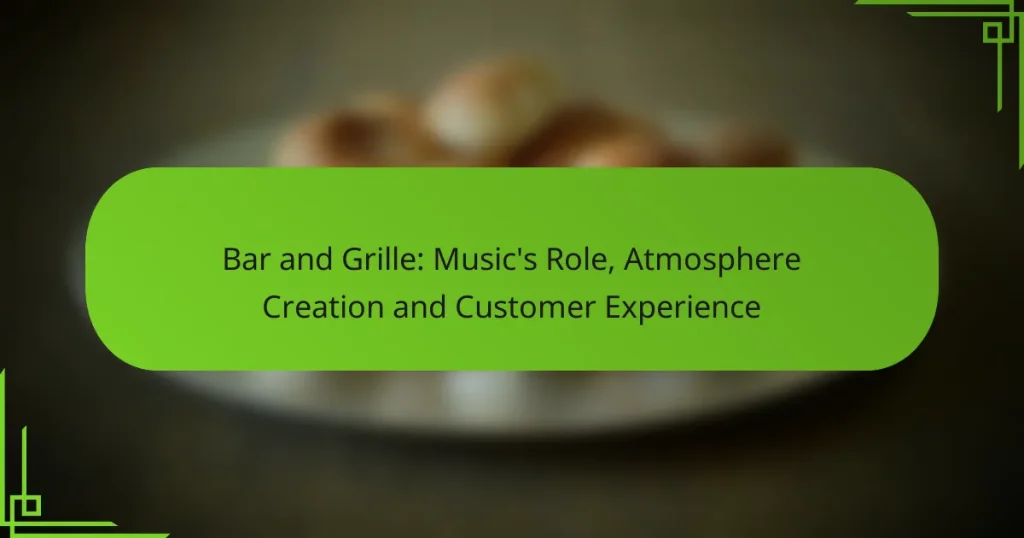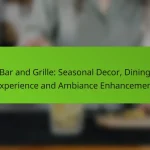In bar and grille settings, music plays a crucial role in shaping the customer experience by creating an inviting atmosphere that encourages social interaction. Whether through live performances, DJ sets, or thoughtfully curated playlists, the right music selection can elevate dining experiences, making them more enjoyable and memorable. This strategic use of music not only enhances the ambiance but also influences how long patrons stay and their likelihood of returning.
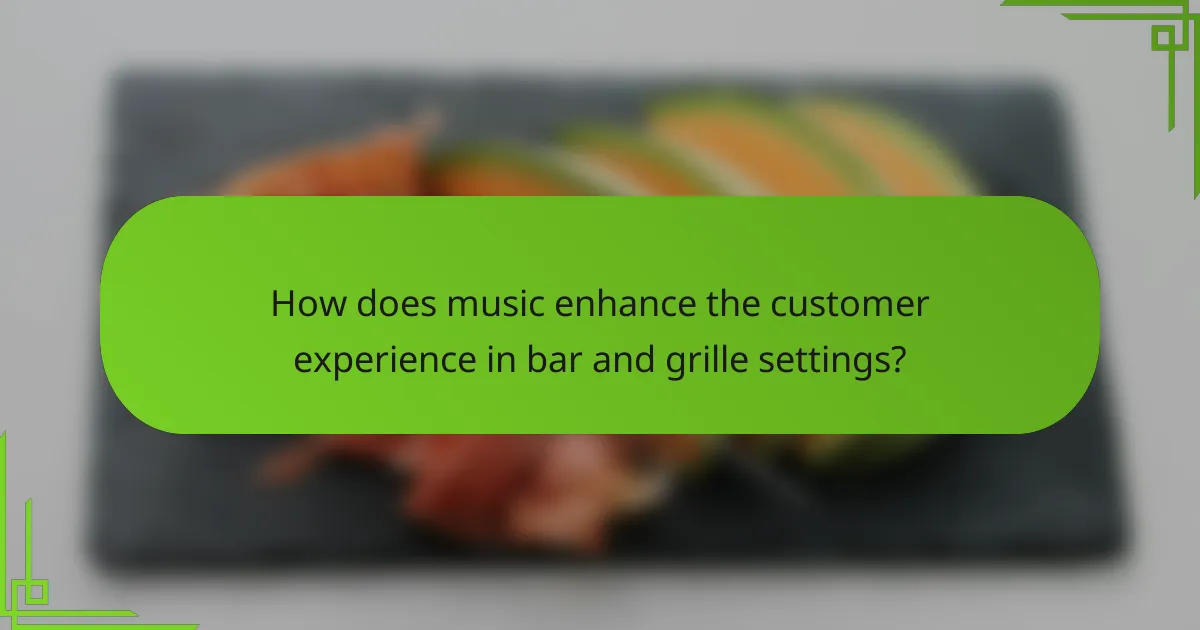
How does music enhance the customer experience in bar and grille settings?
Music significantly enhances the customer experience in bar and grille settings by creating an inviting atmosphere, fostering social interactions, and influencing how long patrons stay. The right music selection can elevate the overall dining experience, making it more enjoyable and memorable.
Creates a lively atmosphere
Music contributes to a lively atmosphere by setting the mood and energizing the environment. Upbeat tracks can encourage a sense of excitement, while softer tunes can create a relaxed vibe, depending on the time of day and target audience.
For instance, during peak hours, playing popular, high-tempo songs can stimulate energy and engagement among guests. In contrast, during quieter times, softer acoustic or jazz music can promote a more intimate dining experience.
Encourages social interaction
Music plays a crucial role in encouraging social interaction among patrons. A well-curated playlist can create a shared experience, prompting conversations and connections between guests.
For example, familiar songs can evoke nostalgia, sparking discussions about personal memories or shared interests. Additionally, music can help break the ice, making it easier for strangers to engage with one another in a social setting.
Influences dining duration
The type and tempo of music can influence how long customers choose to stay and dine. Faster-paced music may encourage quicker service and shorter visits, while slower melodies can lead to longer dining experiences as guests linger over their meals.
Establishments should consider their desired dining duration when selecting music. For instance, a bar aiming for a vibrant, fast-paced atmosphere may opt for upbeat tracks, while a grille focused on leisurely dining might choose soothing background music to encourage guests to relax and enjoy their time.
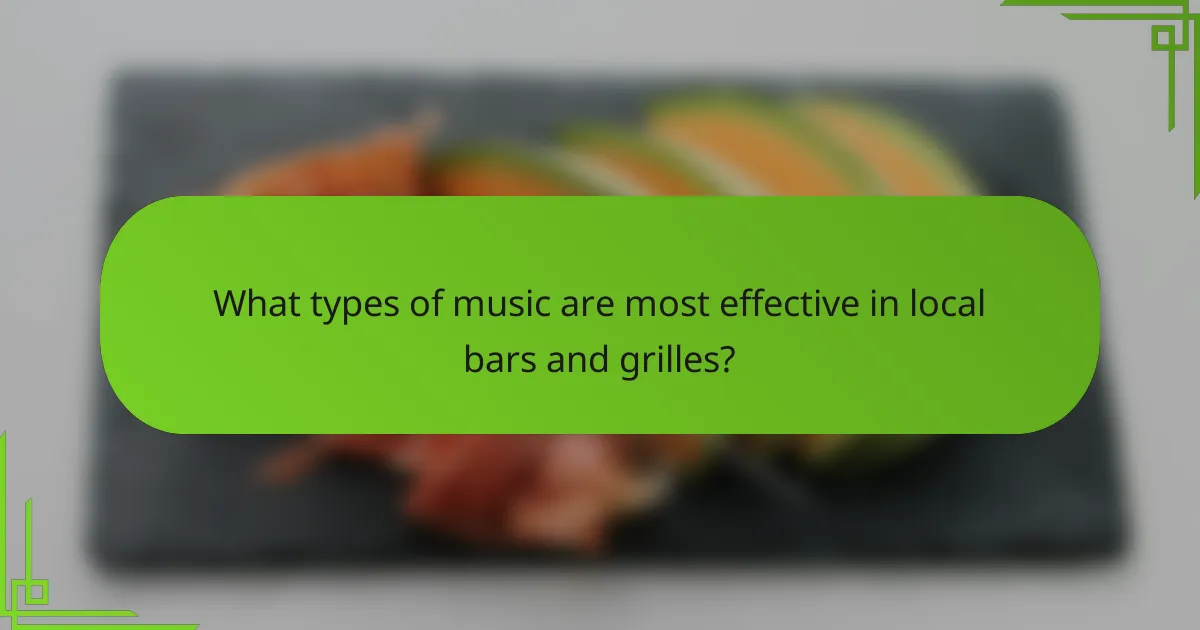
What types of music are most effective in local bars and grilles?
Effective music in local bars and grilles typically includes live bands, DJ sets, and curated background playlists. Each type contributes uniquely to the atmosphere and overall customer experience, influencing how patrons engage with the venue.
Live bands
Live bands create an energetic and engaging atmosphere, often drawing in crowds and enhancing the social experience. They can vary in genre, from jazz to rock, allowing bars to tailor their music selection to their target audience.
Consider hosting local bands to support community talent while keeping costs manageable. A typical performance might last a few hours, providing a lively backdrop for dining and socializing.
DJ sets
DJ sets offer versatility and can adapt to the crowd’s mood throughout the night. A skilled DJ can mix various genres, ensuring the music remains fresh and engaging, which can keep patrons dancing and enjoying their time longer.
When hiring a DJ, consider their experience and ability to read the crowd. A good DJ can significantly enhance the atmosphere, but it’s essential to ensure the volume is appropriate for conversation.
Background playlists
Background playlists provide a consistent and unobtrusive musical experience, setting the tone without overwhelming conversation. Curated playlists can range from upbeat pop to mellow acoustic, depending on the desired ambiance.
Utilize streaming services or create custom playlists that align with your bar’s theme. Regularly updating the playlists can keep the atmosphere fresh and engaging for returning customers.

How does music selection impact customer retention in bars and grilles?
Music selection significantly influences customer retention in bars and grilles by shaping the overall atmosphere and enhancing the dining experience. A carefully curated playlist can create a welcoming environment that encourages patrons to stay longer and return more frequently.
Aligns with brand identity
Music can reinforce a bar or grille’s brand identity by matching the style and theme of the establishment. For example, a sports bar may opt for upbeat, energetic tracks to create a lively atmosphere, while a fine dining grille might choose softer, more sophisticated music to complement an elegant dining experience.
When the music aligns with the brand, it helps establish a coherent identity that customers can connect with, making them more likely to return. Consider using playlists that reflect your brand’s values and target demographic to enhance this alignment.
Enhances emotional connection
Music has the power to evoke emotions, which can significantly enhance the customer experience in bars and grilles. By selecting tracks that resonate with your audience, you can create memorable moments that encourage emotional connections with your establishment.
For instance, playing nostalgic songs can remind customers of positive experiences, making them more likely to associate those feelings with your bar or grille. Regularly updating your playlist and incorporating customer feedback can help maintain this emotional engagement.
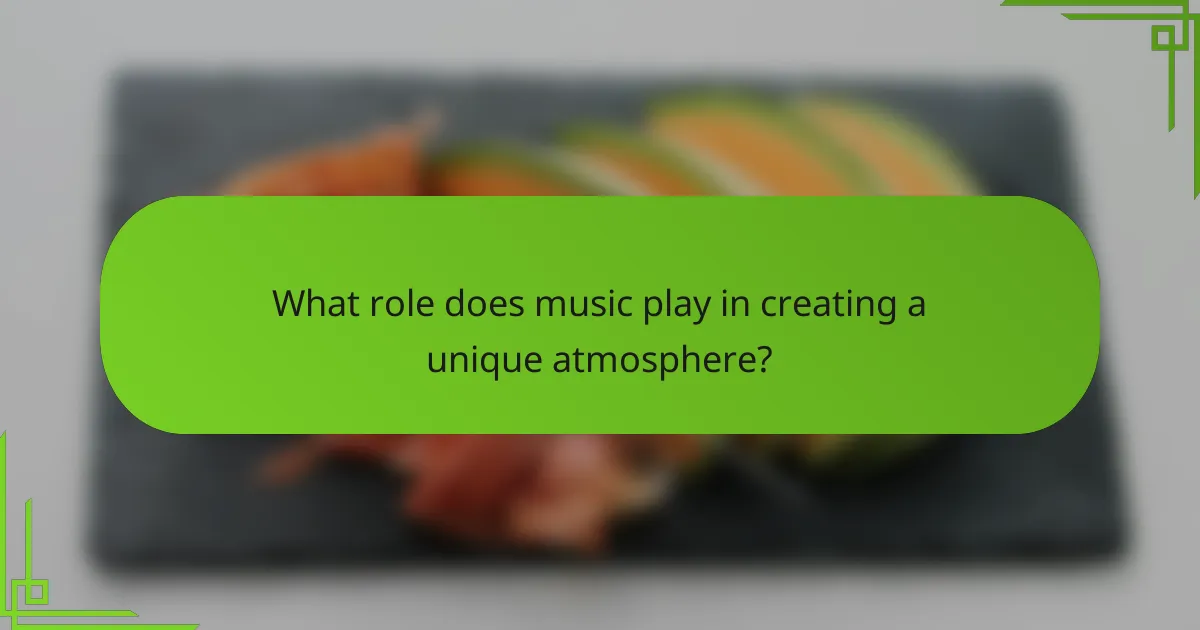
What role does music play in creating a unique atmosphere?
Music significantly contributes to the atmosphere of a bar and grille by influencing the emotional experience of customers. The right selection of tunes can enhance enjoyment, encourage social interaction, and even affect dining choices.
Sets the mood for different times
Music can effectively set the mood for various times of the day, transitioning from upbeat tracks during busy lunch hours to more relaxed melodies in the evening. For instance, playing lively pop or rock music during brunch can energize patrons, while softer acoustic or jazz tunes can create a cozy ambiance for dinner service.
Consider the tempo and genre of music to match the expected crowd. Fast-paced songs can stimulate conversation and activity, while slower rhythms may encourage patrons to linger longer, enhancing their overall experience.
Enhances theme nights
Theme nights benefit greatly from carefully curated music that aligns with the event’s concept. For example, a 1980s night could feature classic hits from that decade, creating a nostalgic atmosphere that encourages participation and engagement. This alignment between music and theme helps reinforce the overall experience for guests.
When planning theme nights, consider creating playlists that not only match the theme but also cater to the demographic of your clientele. Engaging music can elevate the excitement and encourage guests to dress up or participate in themed activities, enhancing their enjoyment and likelihood of returning.
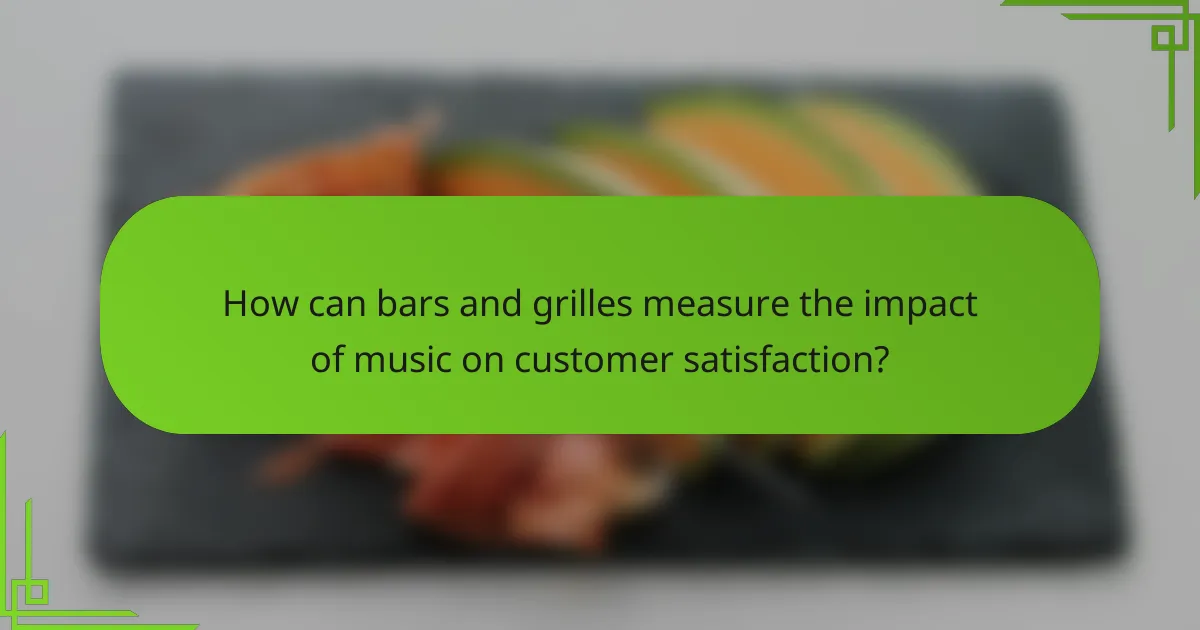
How can bars and grilles measure the impact of music on customer satisfaction?
Bars and grilles can measure the impact of music on customer satisfaction through various methods, including gathering direct feedback from patrons and analyzing sales data. These approaches provide insights into how music influences the overall dining experience and customer retention.
Customer feedback surveys
Customer feedback surveys are a direct way to assess how music affects satisfaction. By asking patrons specific questions about their experience, such as how the music contributed to their enjoyment or whether it influenced their time spent in the establishment, bars can gather valuable insights. Surveys can be conducted through digital platforms or paper forms, and should include both quantitative ratings and qualitative comments.
To maximize response rates, consider offering incentives like discounts on future visits. Aim to survey a diverse group of customers to capture a range of opinions, ensuring that feedback reflects different demographics and preferences.
Sales data analysis
Analyzing sales data can reveal correlations between music choices and customer spending patterns. For instance, if sales increase during specific genres or playlists, this may indicate a positive impact on customer satisfaction. Tracking metrics such as average order value and time spent at tables can provide further insights into how music influences customer behavior.
To effectively analyze sales data, compare periods with different music styles or volumes. This can help identify trends and preferences, allowing bars to tailor their music selections to enhance the customer experience and potentially boost revenue.

What are the best practices for integrating music into the dining experience?
Integrating music into the dining experience enhances atmosphere and customer satisfaction. Effective practices include carefully curating playlists and scheduling live performances to create an engaging environment.
Curating playlists
Curating playlists involves selecting music that complements the overall theme and ambiance of the bar and grille. Consider the time of day and the type of clientele; for instance, upbeat tracks may work well during lunch hours, while softer tunes might be more appropriate for dinner service.
When creating playlists, aim for a mix of genres that appeal to a broad audience while still aligning with your brand identity. Regularly updating the playlist can keep the experience fresh and encourage repeat visits.
Scheduling live performances
Scheduling live performances can significantly enhance the dining experience by providing entertainment that draws in customers. Consider hosting local musicians or bands that align with your venue’s vibe, as this can create a sense of community and attract a loyal following.
When planning live events, be mindful of timing and frequency. Regular performances, such as weekly or monthly events, can establish a routine for patrons. Ensure that the volume of the music allows for conversation, maintaining a balance between entertainment and comfort.

How can local bars and grilles adapt music choices for seasonal events?
Local bars and grilles can enhance their atmosphere and customer experience by curating music selections that align with seasonal events. This involves creating themed playlists and organizing live music that resonates with the spirit of each season, thereby attracting more patrons and fostering a lively environment.
Holiday-themed playlists
Holiday-themed playlists are essential for setting the mood during festive seasons. For example, a bar might feature classic Christmas carols in December or upbeat summer tunes during Fourth of July celebrations. These playlists should reflect the holiday’s essence while considering the preferences of the local clientele.
When creating these playlists, aim for a mix of familiar favorites and newer hits to cater to diverse tastes. Keeping the volume at a level that allows for conversation is crucial; generally, background music should not overpower patrons’ discussions.
Seasonal live music events
Seasonal live music events can significantly enhance customer engagement and create a vibrant atmosphere. For instance, hosting a local band during summer weekends can draw crowds, while acoustic performances in the winter can provide a cozy ambiance. Scheduling these events around holidays or local festivals can maximize attendance.
To ensure success, promote these events through social media and local advertising. Collaborating with local artists not only supports the community but also attracts their fan base, increasing foot traffic and enhancing the overall experience for patrons.
